American actress and dancer Virginia Mayo (1920-2005) is best known for her series of splashy Technicolor musicals with Danny Kaye, including the delightful The Secret Life of Walter Mitty (1947). She personified the quintessential voluptuous Hollywood beauty, like a pin-up painting coming to life. Audiences flocked to cinemas just to see her blonde hair and classic looks on-screen in Technicolor. Going against stereotype, Mayo played the unsympathetic gold-digger Marie Derry in the Oscar-winning drama The Best Years of Our Lives (1946). Later she was a sluttish gun moll opposite James Cagney in White Heat (1949), and Burt Lancaster's leading lady in The Flame and the Arrow (1950). It made Mayo Warner Brothers' biggest box office money maker in the late 1940s.

Vintage postcard by GM. Photo: Warner Bros.

Vintage postcard. Photo: Warner Bros. Virginia Mayo and Ronald Reagan in The Girl From Jones Beach (Peter Godfrey, 1949).
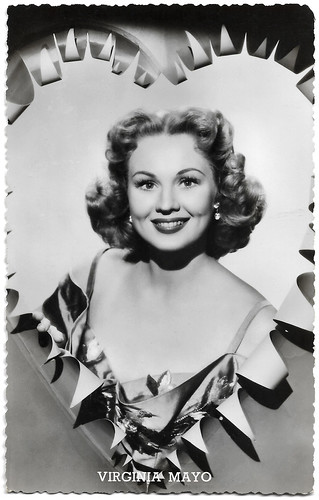
Dutch postcard by Van Leer's Fotodrukindustrie N.V., Amsterdam, no. 251. Photo: Warner Bros.
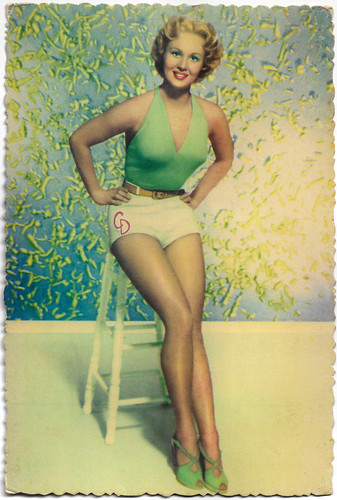
Spanish postcard by Archivo Bermejo, no. 4. Photo: Warner Bros, no. 3522. Photo: Warner Bros.
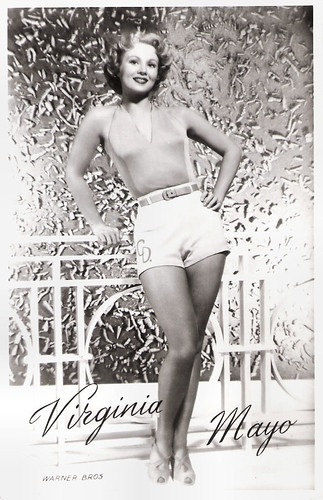
Dutch postcard by Takken, Utrecht, no. 694. Photo: Warner Bros.
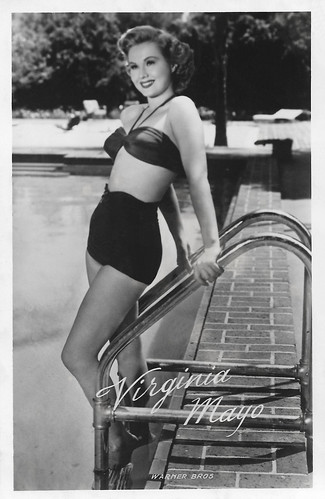
Dutch postcard, no. 3522. Photo: Warner Bros.
Virginia Mayo was born Virginia Clara Jones in 1920 in St. Louis, Missouri. She was the daughter of a newspaper reporter Luke Jones and his wife, Martha Henrietta (née Rautenstrauch) Jones. The family had a rich heritage in the St. Louis area: Virginia's great-great-great-grandfather served in the American Revolution and later founded the city of East Saint Louis, Illinois, in 1797. Virginia was interested in show business from an early age. Her aunt operated an acting school, and Virginia began taking acting and dance lessons at the age of six.
After graduating from high school in 1937, she became a member of the St. Louis Municipal Opera. Impressed with her ability, performer Andy Mayo recruited her to appear in his vaudeville act. Still using her real name of Virginia Jones, she worked for three years in vaudeville with the Mayo Brothers, Mayo and his partner, Nonnie Morton. They did a performing horse act: 'Pansy the Horse' was comprised of Morton and Mayo and Virginia was the ringmaster and comedic foil for Pansy. They also appeared together in some short films. In 1941 Jones, now known by the stage name Virginia Mayo, got another career break as she appeared on Broadway with Eddie Cantor in Banjo Eyes.
After being spotted by an MGM talent scout during this Broadway revue, she was signed to a contract by movie mogul Samuel Goldwyn. Goldwyn only made a few films a year and would usually loan out the actors he had under contract to other producers. David O. Selznick gave Virginia Mayo a screen test but decided she wouldn't fit into films. She was slightly cross-eyed and had to be carefully photographed. Goldwyn, however, believed that her talent as an actress was there and producer Samuel Bronston cast her in a small role in Jack London (Alfred Santell, 1943) opposite her later husband Michael O'Shea. That same year, she had a walk-on part in Follies Girl (William Rowland, 1943) starring Wendy Barrie.
Goldwyn gave her a bit part in Up in Arms (Elliott Nugent, 1944), starring Danny Kaye in his film debut. Then RKO borrowed her for a supporting role in a musical, Seven Days Ashore (John H. Auer, 1944). Believing there was more to her than her obvious ravishing beauty, producers thought it was time to give her bigger and better roles. In 1944 she was cast as Princess Margaret in The Princess and the Pirate (David Butler, 1944), with comedian Bob Hope. It was a spoof of pirate movies and earned over $3 million at the box office. A year later she appeared in Wonder Man (H. Bruce Humberstone, 1945) as the leading lady of Danny Kaye. The film was very popular and so was the radiantly beautiful blonde star.
Her roles may have been coming in slow, but with each one her popularity with audiences rose. Virginia was cast in two more films in 1946, The Kid from Brooklyn (Norman Z. McLeod, 1946), again with Danny Kaye, and The Best Years of Our Lives (William Wyler, 1946). She went against the previous stereotype and played the unsympathetic, gold-digger Marie Derry, who becomes Dana Andrews' unfaithful wife. For this supporting role, she received good notices. The film became the highest-grossing film in the US since Gone with the Wind (Victor Fleming, 1939).
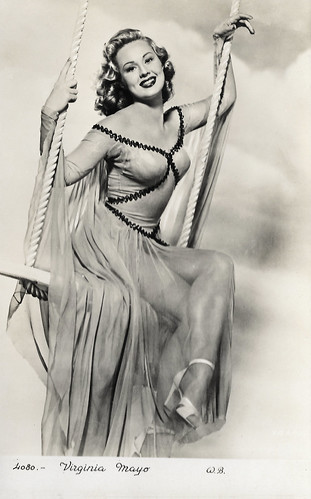
Vintage postcard, no. 4080. Photo: Warner Bros.
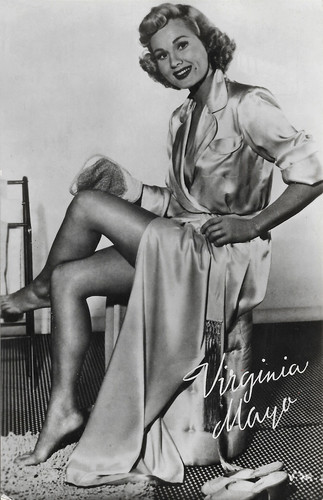
Dutch postcard by DRC, no. F 151. Photo: Warner Bros.

German collectors card in the series E - Filmstars der Welt 2. Band by Greilings-sammelbilder, no. 163. Photo: Hamann / Meyerpress.

Spanish postcard, no. 240/4224. Photo: Archivo Bermejo.

Dutch postcard. Photo: Warner Bros.
Virginia Mayo finally struck pay-dirt in 1947 with a plum assignment in the well-received fantasy-comedy The Secret Life of Walter Mitty (Norman Z. McLeod, 1947) as the gorgeous Rosalind van Hoorn, who uses clumsy, daydreaming Walter Mitty (Danny Kaye) to escape from her pursuer. Walter unintentionally gets involved with a dangerous ring of spies who are seeking a black book with notes about a hidden treasure. Her next film together with Kaye, A Song is Born (Howard Hawks, 1948), was a box office disappointment. Warner Bros ended up taking over her contract from Goldwyn. Mayo got some of the best reviews of her career in James Cagney's return to the gangster genre, White Heat (Raoul Walsh, 1949), as Verna, the scheming, cheating wife of homicidal killer Cody Jarrett (Cagney). She was in another huge hit The Flame and the Arrow (Jacques Tourneur, 1950) as Burt Lancaster's love interest.
Mayo had still more plum roles in the 1950s. She starred in the Film Noir Backfire (Vincent Sherman, 1950) opposite Gordon MacRae. She co-starred again with James Cagney and a young Doris Day in The West Point Story (Roy Del Ruth 1950), singing and dancing with Cagney, and was Gregory Peck's leading lady in Captain Horatio Hornblower (Raoul Walsh, 1951), Warners most popular film of the year. She co-starred with Kirk Douglas in his first Western, Along the Great Divide (Raoul Walsh, 1951).
Parts in the musical She's Working Her Way Through College (H. Bruce Humberstone, 1952) with Ronald Reagan, a biopic of pioneer Jim Bowie The Iron Mistress (Gordon Douglas, 1952) featuring Alan Ladd, and the action-adventure South Sea Woman (Arthur Lubin, 1953) with Burt Lancaster, showed she was still a force to be reckoned with. Although her vocals were always dubbed, she enjoyed doing musicals like She's Working Her Way Through College because she got to dance.
Virginia Mayo co-starred with Rex Harrison and George Sanders in King Richard and the Crusaders (David Butler, 1954) She was Paul Newman's first on-screen leading lady, in the Biblical Epic The Silver Chalice (Victor Saville, 1954). But the film was a notorious flop. She was Cleopatra in the guilty pleasure The Story of Mankind (Irwin Allen, 1957), which tries and fails to jam the entire history of humankind into 100 minutes. As the decade ended, Virginia's career began to slow down. She began guest starring on television shows such as Conflict (1957), Wagon Train (1958), The Loretta Young Show/Letter to Loretta (1958), and Lux Playhouse (1959). Mayo and her husband made a pilot for a TV series McGarry and His Mouse (Norman Tokar, 1960), which was not picked up. She went to Italy to make the Peplum La rivolta dei mercenari / Revolt of the Mercenaries (Piero Costa, 1961) opposite Spanish actor Conrado San Martin. She had four film roles in the 1960s and four more in the following decade.
Mayo appeared on stage in shows like 'That Certain Girl' (1967) and 'Barefoot in the Park' (1968). She continued to act on stage for the rest of her career, mostly in dinner theatre and touring shows. She guest starred on TV shows such as Burke's Law (1965), Daktari (1967), Santa Barbara (1984) and The Love Boat (1986). Among her last films were the horror films Evil Spirits (Gary Graver, 1990) starring Karen Black, and The Man Next Door (Rod C. Spence, 1997). Virginia Mayo died of pneumonia and complications of congestive heart failure at a nursing home in Thousand Oaks, Los Angeles, in 2005. She was 84. In 1947, she married actor Michael O'Shea and remained with him until he died in 1973. The couple had a daughter, Mary Catherine O'Shea, in 1953.
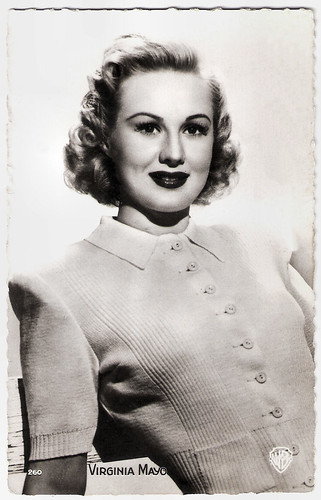
French postcard by Edition P.I., Paris, no. 260. Photo: Warner Bros

Spanish postcard, no. 1218. Photo: Warner Bros. Burt Lancaster and Virginia Mayo in The Flame and the Arrow (Jacques Tourneur, 1950).
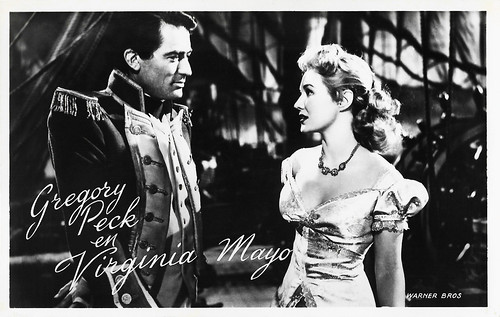
Dutch postcard by Takken, Utrecht, no. 610. Photo: Warner Bros. Publicity still for Captain Horatio Hornblower (Raoul Walsh, 1951) with Gregory Peck.
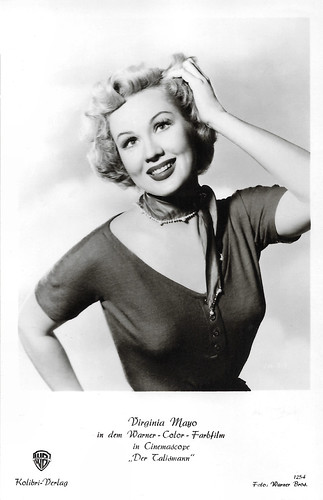
German postcard by Kolibri-Verlag, no. 1254. Photo: Warner Bros. Publicity still for King Richard and the Crusaders (David Butler, 1954).
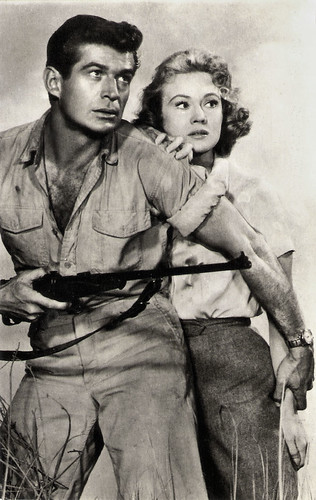
Spanish postcard by F.A.G., no. 440. Photo: Universal. Publicity still for Congo Crossing (Joseph Pevney, 1956) with George Nader.

Italian postcard by Casa Editrice Ballerini & Fratini, Firenze (B.F.F.), no. 3198. Photo: RKO Radio Films.
Sources: Hal Erickson (AllMovie - Page now defunct), Denny Jackson (IMDb), Wikipedia and IMDb.
This post was last updated on 8 July 2025.

Vintage postcard by GM. Photo: Warner Bros.

Vintage postcard. Photo: Warner Bros. Virginia Mayo and Ronald Reagan in The Girl From Jones Beach (Peter Godfrey, 1949).

Dutch postcard by Van Leer's Fotodrukindustrie N.V., Amsterdam, no. 251. Photo: Warner Bros.

Spanish postcard by Archivo Bermejo, no. 4. Photo: Warner Bros, no. 3522. Photo: Warner Bros.

Dutch postcard by Takken, Utrecht, no. 694. Photo: Warner Bros.

Dutch postcard, no. 3522. Photo: Warner Bros.
An obvious ravishing beauty
Virginia Mayo was born Virginia Clara Jones in 1920 in St. Louis, Missouri. She was the daughter of a newspaper reporter Luke Jones and his wife, Martha Henrietta (née Rautenstrauch) Jones. The family had a rich heritage in the St. Louis area: Virginia's great-great-great-grandfather served in the American Revolution and later founded the city of East Saint Louis, Illinois, in 1797. Virginia was interested in show business from an early age. Her aunt operated an acting school, and Virginia began taking acting and dance lessons at the age of six.
After graduating from high school in 1937, she became a member of the St. Louis Municipal Opera. Impressed with her ability, performer Andy Mayo recruited her to appear in his vaudeville act. Still using her real name of Virginia Jones, she worked for three years in vaudeville with the Mayo Brothers, Mayo and his partner, Nonnie Morton. They did a performing horse act: 'Pansy the Horse' was comprised of Morton and Mayo and Virginia was the ringmaster and comedic foil for Pansy. They also appeared together in some short films. In 1941 Jones, now known by the stage name Virginia Mayo, got another career break as she appeared on Broadway with Eddie Cantor in Banjo Eyes.
After being spotted by an MGM talent scout during this Broadway revue, she was signed to a contract by movie mogul Samuel Goldwyn. Goldwyn only made a few films a year and would usually loan out the actors he had under contract to other producers. David O. Selznick gave Virginia Mayo a screen test but decided she wouldn't fit into films. She was slightly cross-eyed and had to be carefully photographed. Goldwyn, however, believed that her talent as an actress was there and producer Samuel Bronston cast her in a small role in Jack London (Alfred Santell, 1943) opposite her later husband Michael O'Shea. That same year, she had a walk-on part in Follies Girl (William Rowland, 1943) starring Wendy Barrie.
Goldwyn gave her a bit part in Up in Arms (Elliott Nugent, 1944), starring Danny Kaye in his film debut. Then RKO borrowed her for a supporting role in a musical, Seven Days Ashore (John H. Auer, 1944). Believing there was more to her than her obvious ravishing beauty, producers thought it was time to give her bigger and better roles. In 1944 she was cast as Princess Margaret in The Princess and the Pirate (David Butler, 1944), with comedian Bob Hope. It was a spoof of pirate movies and earned over $3 million at the box office. A year later she appeared in Wonder Man (H. Bruce Humberstone, 1945) as the leading lady of Danny Kaye. The film was very popular and so was the radiantly beautiful blonde star.
Her roles may have been coming in slow, but with each one her popularity with audiences rose. Virginia was cast in two more films in 1946, The Kid from Brooklyn (Norman Z. McLeod, 1946), again with Danny Kaye, and The Best Years of Our Lives (William Wyler, 1946). She went against the previous stereotype and played the unsympathetic, gold-digger Marie Derry, who becomes Dana Andrews' unfaithful wife. For this supporting role, she received good notices. The film became the highest-grossing film in the US since Gone with the Wind (Victor Fleming, 1939).

Vintage postcard, no. 4080. Photo: Warner Bros.

Dutch postcard by DRC, no. F 151. Photo: Warner Bros.

German collectors card in the series E - Filmstars der Welt 2. Band by Greilings-sammelbilder, no. 163. Photo: Hamann / Meyerpress.

Spanish postcard, no. 240/4224. Photo: Archivo Bermejo.

Dutch postcard. Photo: Warner Bros.
The scheming, cheating wife of a homicidal killer
Virginia Mayo finally struck pay-dirt in 1947 with a plum assignment in the well-received fantasy-comedy The Secret Life of Walter Mitty (Norman Z. McLeod, 1947) as the gorgeous Rosalind van Hoorn, who uses clumsy, daydreaming Walter Mitty (Danny Kaye) to escape from her pursuer. Walter unintentionally gets involved with a dangerous ring of spies who are seeking a black book with notes about a hidden treasure. Her next film together with Kaye, A Song is Born (Howard Hawks, 1948), was a box office disappointment. Warner Bros ended up taking over her contract from Goldwyn. Mayo got some of the best reviews of her career in James Cagney's return to the gangster genre, White Heat (Raoul Walsh, 1949), as Verna, the scheming, cheating wife of homicidal killer Cody Jarrett (Cagney). She was in another huge hit The Flame and the Arrow (Jacques Tourneur, 1950) as Burt Lancaster's love interest.
Mayo had still more plum roles in the 1950s. She starred in the Film Noir Backfire (Vincent Sherman, 1950) opposite Gordon MacRae. She co-starred again with James Cagney and a young Doris Day in The West Point Story (Roy Del Ruth 1950), singing and dancing with Cagney, and was Gregory Peck's leading lady in Captain Horatio Hornblower (Raoul Walsh, 1951), Warners most popular film of the year. She co-starred with Kirk Douglas in his first Western, Along the Great Divide (Raoul Walsh, 1951).
Parts in the musical She's Working Her Way Through College (H. Bruce Humberstone, 1952) with Ronald Reagan, a biopic of pioneer Jim Bowie The Iron Mistress (Gordon Douglas, 1952) featuring Alan Ladd, and the action-adventure South Sea Woman (Arthur Lubin, 1953) with Burt Lancaster, showed she was still a force to be reckoned with. Although her vocals were always dubbed, she enjoyed doing musicals like She's Working Her Way Through College because she got to dance.
Virginia Mayo co-starred with Rex Harrison and George Sanders in King Richard and the Crusaders (David Butler, 1954) She was Paul Newman's first on-screen leading lady, in the Biblical Epic The Silver Chalice (Victor Saville, 1954). But the film was a notorious flop. She was Cleopatra in the guilty pleasure The Story of Mankind (Irwin Allen, 1957), which tries and fails to jam the entire history of humankind into 100 minutes. As the decade ended, Virginia's career began to slow down. She began guest starring on television shows such as Conflict (1957), Wagon Train (1958), The Loretta Young Show/Letter to Loretta (1958), and Lux Playhouse (1959). Mayo and her husband made a pilot for a TV series McGarry and His Mouse (Norman Tokar, 1960), which was not picked up. She went to Italy to make the Peplum La rivolta dei mercenari / Revolt of the Mercenaries (Piero Costa, 1961) opposite Spanish actor Conrado San Martin. She had four film roles in the 1960s and four more in the following decade.
Mayo appeared on stage in shows like 'That Certain Girl' (1967) and 'Barefoot in the Park' (1968). She continued to act on stage for the rest of her career, mostly in dinner theatre and touring shows. She guest starred on TV shows such as Burke's Law (1965), Daktari (1967), Santa Barbara (1984) and The Love Boat (1986). Among her last films were the horror films Evil Spirits (Gary Graver, 1990) starring Karen Black, and The Man Next Door (Rod C. Spence, 1997). Virginia Mayo died of pneumonia and complications of congestive heart failure at a nursing home in Thousand Oaks, Los Angeles, in 2005. She was 84. In 1947, she married actor Michael O'Shea and remained with him until he died in 1973. The couple had a daughter, Mary Catherine O'Shea, in 1953.

French postcard by Edition P.I., Paris, no. 260. Photo: Warner Bros

Spanish postcard, no. 1218. Photo: Warner Bros. Burt Lancaster and Virginia Mayo in The Flame and the Arrow (Jacques Tourneur, 1950).

Dutch postcard by Takken, Utrecht, no. 610. Photo: Warner Bros. Publicity still for Captain Horatio Hornblower (Raoul Walsh, 1951) with Gregory Peck.

German postcard by Kolibri-Verlag, no. 1254. Photo: Warner Bros. Publicity still for King Richard and the Crusaders (David Butler, 1954).

Spanish postcard by F.A.G., no. 440. Photo: Universal. Publicity still for Congo Crossing (Joseph Pevney, 1956) with George Nader.

Italian postcard by Casa Editrice Ballerini & Fratini, Firenze (B.F.F.), no. 3198. Photo: RKO Radio Films.
Sources: Hal Erickson (AllMovie - Page now defunct), Denny Jackson (IMDb), Wikipedia and IMDb.
This post was last updated on 8 July 2025.
No comments:
Post a Comment